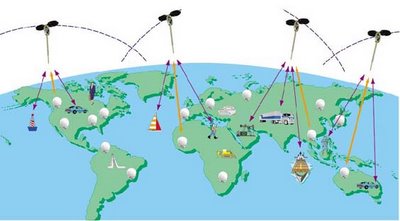ElectriPlast -- Role in Asset Tracking / Security…

The
Future
of Asset
Tracking
and
Container
Security?
By PK
ElectriPlast Blog Publisher
[ElectriPlast Blog Publisher's Note: The Dubai Ports World controversy has thrust maritime, port and shipping security to the forefront of national security issues. However, years ago, before this became a hot button issue, Integral Technologies addressed this and other container security concerns.]
A number of years ago, Integral Technologies sought to address many of those concerns with the introduction of their flat panel satellite antenna, which was specifically designed to work with the Low Earth Orbit (LEO) satellite system operated by ORBCOMM. The idea behind this unique antenna was simple.
- On cargo containers, it could be placed in an obscure position on the top or side to monitor the containers' location. One configuration of this antenna could also transmit signals to indicate cargo tampering.
- The flat panel satellite antenna, coupled with other technology, could be embedded in expensive heavy-duty construction and mining equipment. In the event that the equipment was stolen, the technology accompanying the antenna could "call home," thus making tracking and recovery a reality.
- At oil and gas pipelines or similarly isolated sites, the flat panel antenna could assist pipeline personnel with monitoring and controlling switches remotely.
- Moreover, refrigerated fleet vehicles could be configured with a flat panel antenna that not only monitors the vehicle for location and the container for tampering, but could also monitor the temperature within the container, alerting the driver and dispatch office of potential problems during transit. Finally, the satellite link can provide real time data- and voice-links between the driver and the dispatcher.
It was in the midst of creating a unique epoxy solution for the flat panel antenna that Integral's chief technology officer, Mr. Thomas Aisenbrey, discovered the key to Plastenna and later ElectriPlast.
It was not the writer's intention to ride the coattails of the current media storm surrounding the failed Dubai World Ports deal, nor was it meant to highlight security issues and lapses in US port security. This is merely a continuation of the ElectriPlast story based on historical data and patent information. Furthermore, this article is intended to show that the ElectriPlast story is not a one-off wonder; it is based in reality and has the capacity to touch real-world concerns and interests in countless ways.
That ElectriPlast and the flat panel satellite antenna can enhance highway, railway and maritime asset security is a compelling story.
During these uncertain times, this speaks positively to the obvious need and the credible role that Integral's ElectriPlast enhanced flat panel satellite antenna platform might play in enhancing the country's overall security.
----------------------------------
An Outside Patent Application involving ElectriPlast technology:
By Ray W.
ElectriPlast Blog Reader
Special to the ElectriPlast Blog
Linked below is a patent application dated: 8 September 2005.
This patent comes from a company familiar with Integral's Flat Panel satellite antenna--but more importantly, it focuses on the subject at hand, an enhanced new "Shipping Container Security System." Herein, you will note that the drafter purposely incorporates the preferred use of Integral’s ElectriPlast antenna (Plastenna) technology to enhance their patent proposition. . .
[0047] Therefore, this invention eliminates the security system receiver in container 2 and employs only a transmitter, such as transmitter 11 that transmits a repetitious pattern of low duty cycle data transmissions, and/or a pattern of data transmission that are triggered by motion sensor 52 or door switch 12. Transmitter 11 is based on a commercially available transmitter employed in home and industrial security systems that regularly transmits supervisory messages, such as every hour or every four hours. Transmitter 11 can operate longer than five years on a single 3-volt Lithium 2/3A cell. Transmitter 11 is preferably a model number 60-917-95, and receiver 7 is preferably a model number 60-764-01-95R-MAX, both of which are manufactured by GE-Interlogix located in North Saint Paul, Minn. Transmitter 11 resists tampering by employing an antenna 54 that is hidden and protected in a corrugated strengthening "slot" on the exterior of container 2. The antenna is preferably a "Plastenna" model manufactured by Integral Technologies, Inc. located in Bellingham, Wash.








0 Comments:
Post a Comment
<< Home